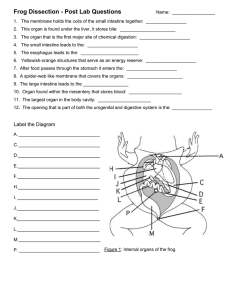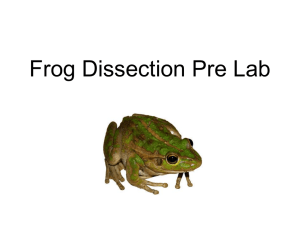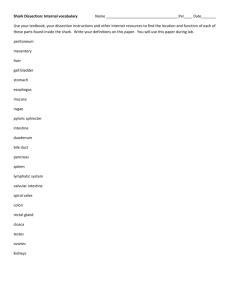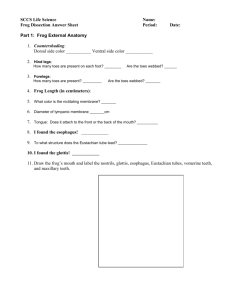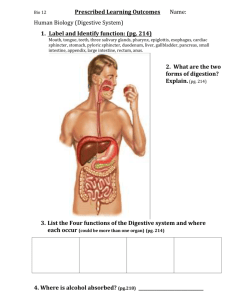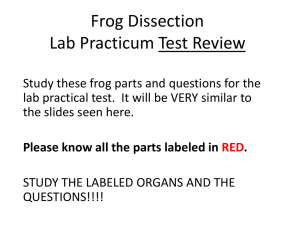09 Frog TH Exam
advertisement
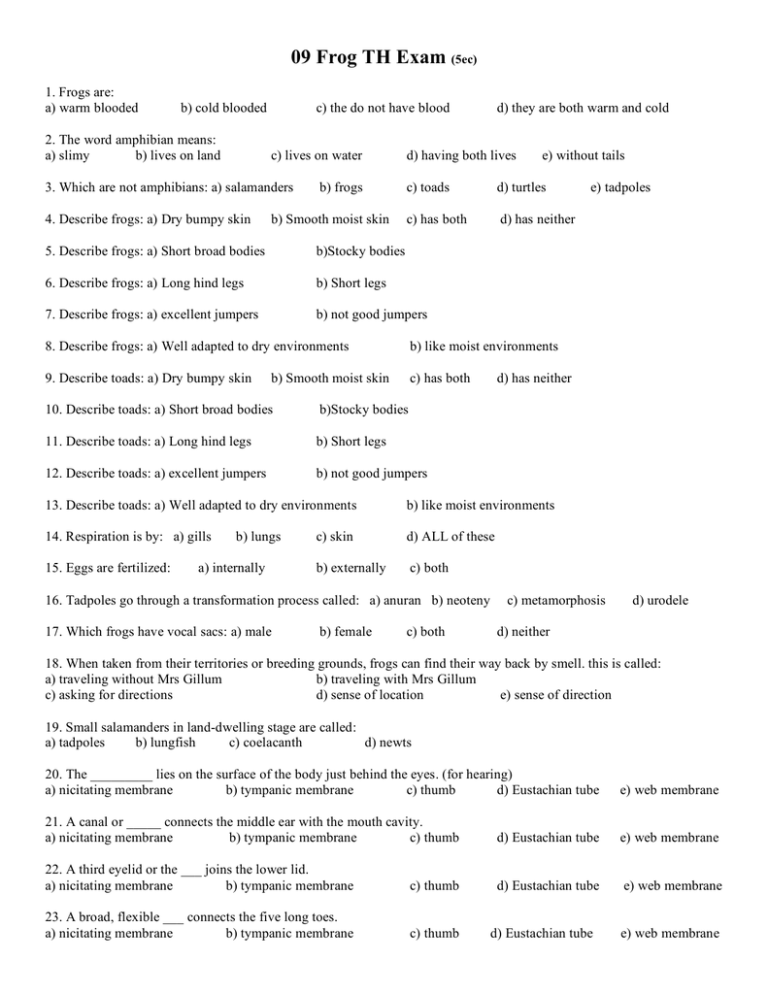
09 Frog TH Exam (5ec) 1. Frogs are: a) warm blooded b) cold blooded 2. The word amphibian means: a) slimy b) lives on land c) the do not have blood c) lives on water 3. Which are not amphibians: a) salamanders 4. Describe frogs: a) Dry bumpy skin b) frogs b) Smooth moist skin d) they are both warm and cold d) having both lives e) without tails c) toads d) turtles c) has both d) has neither 5. Describe frogs: a) Short broad bodies b)Stocky bodies 6. Describe frogs: a) Long hind legs b) Short legs 7. Describe frogs: a) excellent jumpers b) not good jumpers 8. Describe frogs: a) Well adapted to dry environments b) like moist environments 9. Describe toads: a) Dry bumpy skin c) has both b) Smooth moist skin 10. Describe toads: a) Short broad bodies b)Stocky bodies 11. Describe toads: a) Long hind legs b) Short legs 12. Describe toads: a) excellent jumpers b) not good jumpers d) has neither 13. Describe toads: a) Well adapted to dry environments b) like moist environments 14. Respiration is by: a) gills c) skin d) ALL of these b) externally c) both 15. Eggs are fertilized: b) lungs a) internally 16. Tadpoles go through a transformation process called: a) anuran b) neoteny 17. Which frogs have vocal sacs: a) male b) female c) both e) tadpoles c) metamorphosis d) urodele d) neither 18. When taken from their territories or breeding grounds, frogs can find their way back by smell. this is called: a) traveling without Mrs Gillum b) traveling with Mrs Gillum c) asking for directions d) sense of location e) sense of direction 19. Small salamanders in land-dwelling stage are called: a) tadpoles b) lungfish c) coelacanth d) newts 20. The _________ lies on the surface of the body just behind the eyes. (for hearing) a) nicitating membrane b) tympanic membrane c) thumb d) Eustachian tube e) web membrane 21. A canal or _____ connects the middle ear with the mouth cavity. a) nicitating membrane b) tympanic membrane c) thumb d) Eustachian tube e) web membrane 22. A third eyelid or the ___ joins the lower lid. a) nicitating membrane b) tympanic membrane c) thumb d) Eustachian tube e) web membrane 23. A broad, flexible ___ connects the five long toes. a) nicitating membrane b) tympanic membrane c) thumb d) Eustachian tube e) web membrane 24. This identifies a male or a female. a) nicitating membrane b) tympanic membrane c) thumb d) Eustachian tube 25. The thick sticky tongue is attached to the floor of the mouth at the: a) front 26. The thick sticky tongue has how many projections on the free end? a) 1 b) middle b) 2 e) web membrane c) back c) 3 d) glottis d) 4 27. These project from bones of the roof of the mouth, and aid in the holding of prey: a) no teeth b) maxillary teeth c) Vomerine teeth d) dentures 28. This describes the teeth on the lower jaw : a) no teeth b) maxillary teeth c) Vomerine teeth d) dentures 29. Small _____ project from the upper jawbone, and also aid in holding prey. a) no teeth b) maxillary teeth c) Vomerine teeth d) dentures 30. This leads to the stomach a) olfactory 31. This leads to the opening of the lungs 32. This is the lobe present by the eyes b) optic a) olfactory a) olfactory c) glottis b) optic b) optic d) gullet e) medulla c) glottis c) glottis d) gullet d) gullet e) medulla e) medulla 33. The back surface in an erect standing animal, the upper surface in an animal such as a fish or frog. a) Bile b) Stomach c) Dorsal d) Ventral 34. Temporary storage site of food in which the process of digestion begins. a) Bile b) Stomach c) Small intestine d) gullet 35. Greenish liquid produced by the liver, stored in the gall bladder. Its function is to break down fats and oils. a) acetic acid b) carbonic acid c) bile d) blood 36. The front surface of an erect standing animal, the under surface in an animal such as a fish or frog. a) Bile b) Stomach c) Dorsal d) Ventral 37. Teeth found on the upper jaw bone. a) Nostrils b) Eustachian tubes c) Vomerine teeth d) Maxillary teeth e) canine teeth 38. Two knob-like, backward slanting teeth, located on the upper jaw of the frog. a) Nostrils b) Eustachian tubes c) Vomerine teeth d) Maxillary teeth e) canine teeth 39. Tube leading from the throat to the inside of the tympanic membrane of the ear. The purpose is to equalize the pressure inside the ear to that outside the ear. a) Nostrils b) Eustachian tubes c) Vomerine teeth d) Maxillary teeth e) esophagus 40. Opening through which the frog is able to breath air. a. Nostrils b. Eustachian tubes c. cloaca d. gullet e. esophagus 41. Fly-catching device in the frog. Its attachment in the front allows it to reach great lengths. a. Mesentery b. Tongue c. Gullet d. Glottis e. Lymph nodes 42. Horizontal opening in the center of the mouth which leads to the esophagus and then the stomach. Food is swallowed through here. a. Mesentery b. Tongue c. Gullet d. Glottis e. Lymph nodes 43. A vertical slit in the bottom jaw just anterior to the gullet. This is the air passage to the lungs. a. Mesentery b. Tongue c. Gullet d. Glottis e. Lymph nodes 44. Structures found under the skin in the lower jaw. They are part of the immune system and serve as disease fighting stations. a. Mesentery b. Tongue c. Gullet d. Glottis e. Lymph nodes 45. Transparent connective tissues which hold internal organs in place. a. Mesentery b. Tongue c. Gullet d. Glottis e. Lymph nodes 46. The covering over the ear of the frog. Also the eardrum in humans. a. Testicles b. Tympanic membrane c. Nictitating membrane d. Oviducts e. Gall bladder 47. Small greenish sack beneath the right lobe of the liver which stores the bile produced by the liver. a. Testicles b. Tympanic membrane c. Nictitating membrane d. Oviducts e. Gall bladder 48. The covering over the eye in a frog. a. Testicles b. Tympanic membrane c. Nictitating membrane d. Oviducts e. Gall bladder 49. Tubes which carry the eggs. a. Testicles b. Tympanic membrane c. Nictitating membrane d. Oviducts e. Gall bladder 50. Male reproductive organs which produce sperm. a. Testicles b. Tympanic membrane c. Nictitating membrane d. Oviducts e. Gall bladder 51. Located to each side of the liver lobes. They are quite small for an animal of this size but will fill with oxygen a. Fat bodies b. Spleen c. Lungs d. Cloaca e. Esophagus 52. Brown, bean shaped organ found below the stomach on the left side of your frog. Its function is to store blood cells. a. a. Fat bodies b. Spleen c. Lungs d. Cloaca e. Esophagus 53.-a common reproductive, excretory organ in the frog just before the anus. a. Fat bodies b. Spleen c. Lungs d. Cloaca e. Esophagus 54. The tail end of an organism, also may be used to refer to the back or behind something else. a. Anterior b. Posterior c. Ventricle d. Atrium e. heart 55. Tube which serves as a passageway for food from the gullet to the stomach. a. Fat bodies b. Spleen c. Lungs d. Cloaca e. Esophagus 56. Organ responsible for the pumping of blood throughout an organism. a. Anterior b. Posterior c. Ventricle d. Atrium e. heart 57. Organs comprised of fat. These structures will be the food source for the frog throughout its winter hibernation. a. Fat bodies b. Spleen c. Lungs d. Cloaca e. Esophagus 58. The front end or in front of something else. a. Anterior b. Posterior c. Ventricle d. Atrium e. heart 59. Two long reddish organs located one on either side of the backbone. Its function is to filter the blood. a. Small intestine b. Kidneys c. Liver d. Pancreas e. Ovaries 60. Coiled tube in which most of the process of digestion and absorption of food occurs a. Small intestine b. Kidneys c. Liver d. Pancreas e. Ovaries 61. -the lower portions of the heart which pump blood out to the body. a. Anterior b. Posterior c. Ventricle d. Atrium e. heart 62. Narrow band of whitish tissue found at the crook of the stomach. It produces several digestive enzymes. a. Small intestine b. Kidneys c. Liver d. Pancreas e. Ovaries 63. Upper chambers of the heart which serve to collect blood returning to the heart from the body. a. Anterior b. Posterior c. Ventricle d. Atrium e. heart 64. Female reproductive glands which produce eggs. a. Small intestine b. Kidneys c. Liver d. Pancreas e. Ovaries 65. Largest organ of the body produces and stores many substances vital to the existence of the organism. The frog has three lobes. a. Sm intestine b. Kidneys c. Liver d. Pancreas e. Ovaries 66. What system is structure A part of? a. respiration b. digestion c. reproduction d. circulation e. nervous 67. What system is structure B part of? a. respiration b. digestion c. reproduction d. circulation e. nervous 68. What system is structure D part of? a. respiration b. digestion c. reproduction d. circulation e. nervous 69. What system is structure E part of? a. respiration b. digestion c. reproduction d. circulation e. nervous 70. What system is structure I part of? a. respiration b. digestion c. reproduction d. circulation e. nervous 71. What system is structure J part of? a. respiration b. digestion c. reproduction d. circulation e. nervous 72. What system is structure O part of? a. respiration b. digestion c. reproduction d. circulation e. nervous 73. What system is structure P part of? a. respiration b. digestion c. reproduction d. circulation e. nervous 74. What system is structure Q part of? a. respiration b. digestion c. reproduction d. circulation e. nervous 75. What system is structure R part of? a. respiration b. digestion c. reproduction d. circulation e. nervous 76. Which letter indicates the left anterior lobe of the liver? a) A b) B c) C d) D 77. The letter "X" indicates the: a) spleen b) duodenum c) gall bladder d) stomach 78. The letter "Y" indicates the: a) small intestine b) large intestine c) oviducts d) fat bodies 79. The function of "X" is: a) cleanse blood b) store bile c) digest food d) circulation 80. The letter "F" indicates the: a) ileum of the small intestine b) duodenum of the small intestine c) large intestine d) fat bodies 81. The letter "G" indicates the: a) ileum of the small intestine b) duodenum of the small intestine c) large intestine d) urinary bladder 82. Both "F" and "G" belong to what system? a) digestive b) urogenital c) circulatory d) respiratory 83. The letter "M" indicates the: a) gall bladder b) heart c) stomach d) spleen 84. The ledder "N" indicates the: a) stomach b) large intestine c) urinary bladder d) spleen 85. The letter "N" structure belongs to which system? a) digestive b) urogenital c) respiratory d) circulatory 86. Eggs, sperm, and wastes all exit out of this structure: a) esophagus b) pyloric sphincter 87.The largest organ in the frog's body cavity is the: a) heart b) liver c) stomach 88. Bile stored by the gall bladder is directed into what structure? a) liver c) cloaca d) duodenum d) lg.intestine b) duodenum c) cloaca d) heart 89. The frog heart has how many chambers: a) 1 b) 2 c) 3 d) 4 Match the word to it’s definition: 90. Coiled tube in which most of the process of digestion and absorption of food occurs a. atrium b. spleen c. lungs d. small intestine e. cloaca 91. Located to each side of the liver lobes. They are quite small for an animal of this size but will fill with oxygen a. atrium b. spleen c. lungs d. small intestine e. cloaca 92. Brown, bean shaped organ found below the stomach on the left side of your frog. Its function is to store blood cells. a. atrium b. spleen c. lungs d. small intestine e. cloaca 93. a common reproductive, excretory organ in the frog just before the anus. a. atrium b. spleen c. lungs d. small intestine e. cloaca 94. Upper chambers of the heart which serve to collect blood returning to the heart from the body. a. atrium b. spleen c. lungs d. small intestine e. cloaca 95. Tube which serves as a passageway for food from the gullet to the stomach. a. pancreas b. fat bodies c. kidneys d. esophagus e. ovaries 96. Narrow band of whitish tissue found at the crook of the stomach. It produces several digestive enzymes. a. pancreas b. fat bodies c. kidneys d. esophagus e. ovaries 97. Organs comprised of fat. These structures will be the food source for the frog throughout its winter hibernation. a. pancreas b. fat bodies c. kidneys d. esophagus e. ovaries 98. Female reproductive glands which produce eggs. a. pancreas b. fat bodies c. kidneys d. esophagus e. ovaries 99. Two long reddish organs located one on either side of the backbone. Its function is to filter the blood. a. pancreas b. fat bodies c. kidneys d. esophagus e. ovaries 100; Much to my amazement I really know a lot about the frog: a) TRUE TRUE TRUE b) we were learning about the frog?? I thought this was a pig
